Maine's newest resort course opened a few years ago with high expectations. Designed by Robert Trent Jones, the mountain layout is in some respects a sister course to the widely praised Sugarloaf Golf Course. In New England, Sugarloaf has a reputation for incredible scenery and brutally tight fairways. There was speculation (mostly driven by the PR folks, I think) that Sunday River would match Sugarloaf's vistas while providing more open and friendly playing corridors.
I had wanted to see the course since construction pictures first started appearing online in the early stages of the project. I finally got up to Bethel, Maine, yesterday on a perfect 80 degree day.
Pulling into the parking lot, you can see immediately that great care went into the site. The clubhouse is a cool log-sided structure with a big deck looking out over the first tee. It was a great spot for lunch before teeing off. There is also a very nice range, although the range balls are extra—something that always bugs me when you are paying $100 in greens fees.
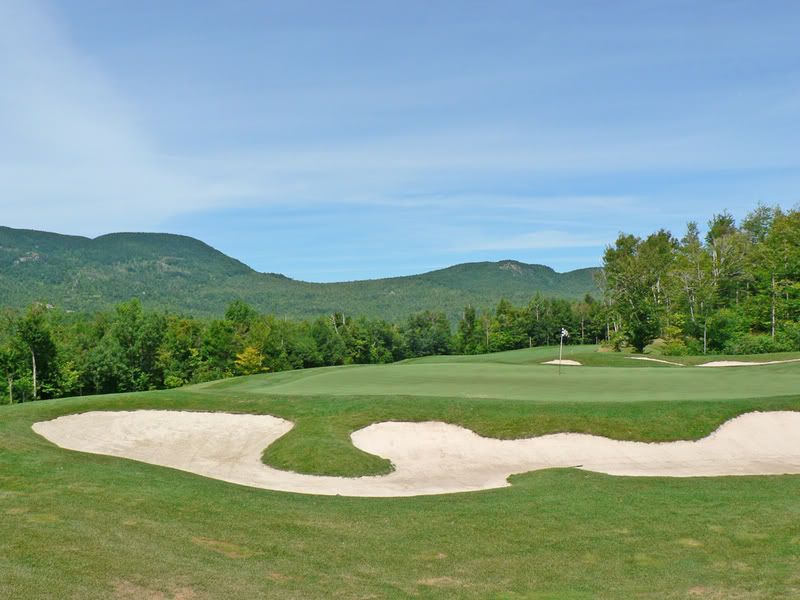
The first hole is a downhill, dogleg left par 5. Unfortunately, the course ran out of yardage books, so we had no idea where to aim our tee shot. There was a bunker positioned at the elbow that looked relatively close. We asked the starter how far to reach the corner and, in typical Maine fashion, he replied, "to the corner." Very helpful. In any event, we hit good tee shots down the left and then, in looking back, figured the bunker had to be at least 280 from the tee. Favoring the right leaves a much better angle to come into the green, because the fairway continues to bend to the left around trees. The hole has a significant elevation drop, which meant that even from the left you can go up and over the trees with a 7-iron from about 190 and still reach the green. Not a bad start. The photo is from the left side of the first green.
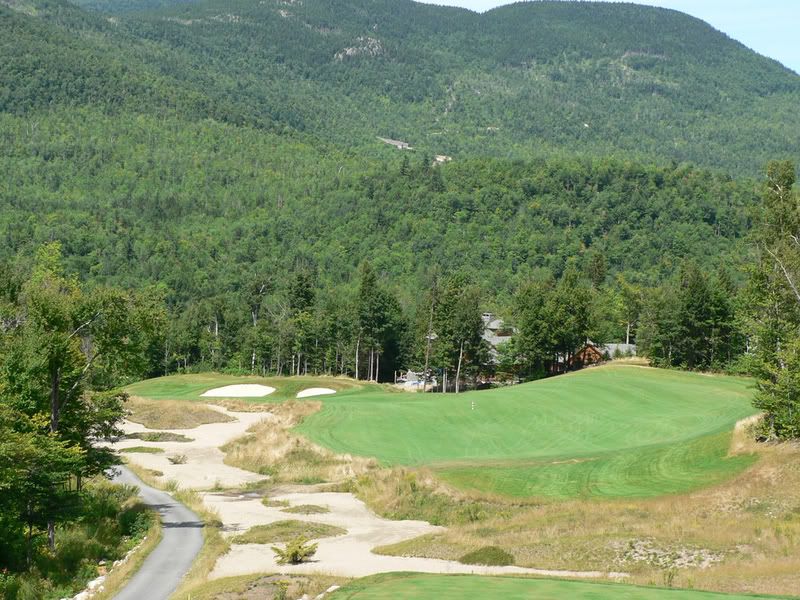
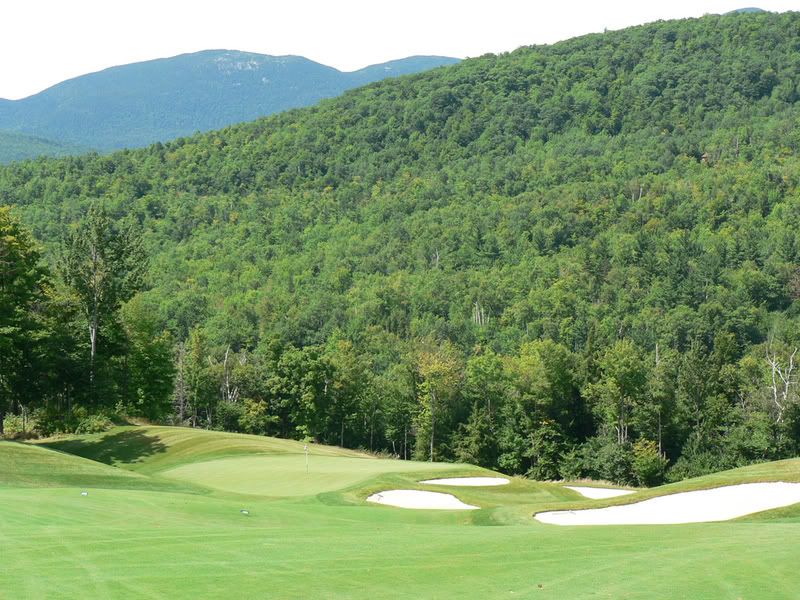
The second is a 380-yard par four that again doglegs left and plays waaaay downhill. Once again, without a yardage book or person in the group with local knowledge, we had no idea how much of the dogleg to cut off so we played short with irons. That left a downhill shot to a pretty funky green.
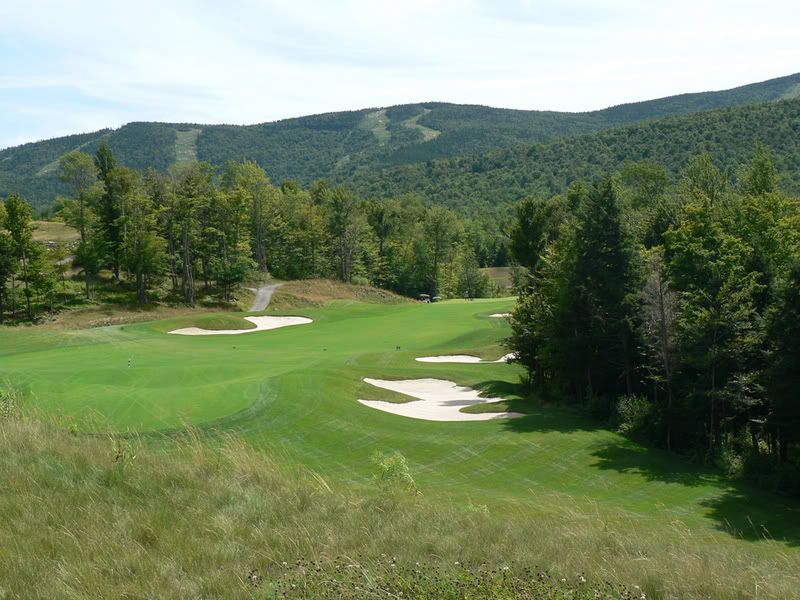
The third is a good hole that drops off the tee and then climbs gradually up to the green. It's another shorty of only 330 yards. I had just bought an Adams 18 degree hybrid, and hitting it over the bunkers on the right left about 80 yards to the middle.
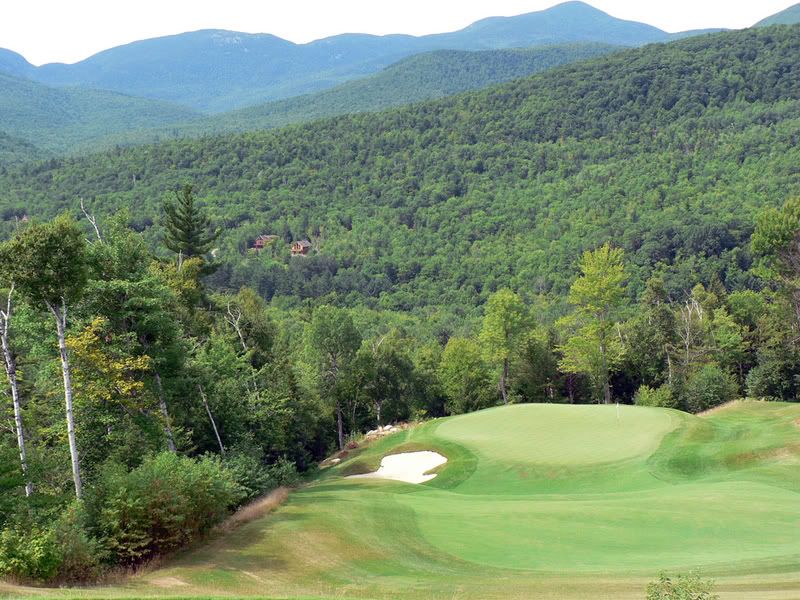
The first par 3 might be the most dramatic hole on the course. I'm not a good judge of elevation change, but it seems as though there must be at least 50 feet of drop on this 175-yard hole. A wedge was plenty, although everyone in our group missed to the right after seeing the nothingness that engulfs the left.
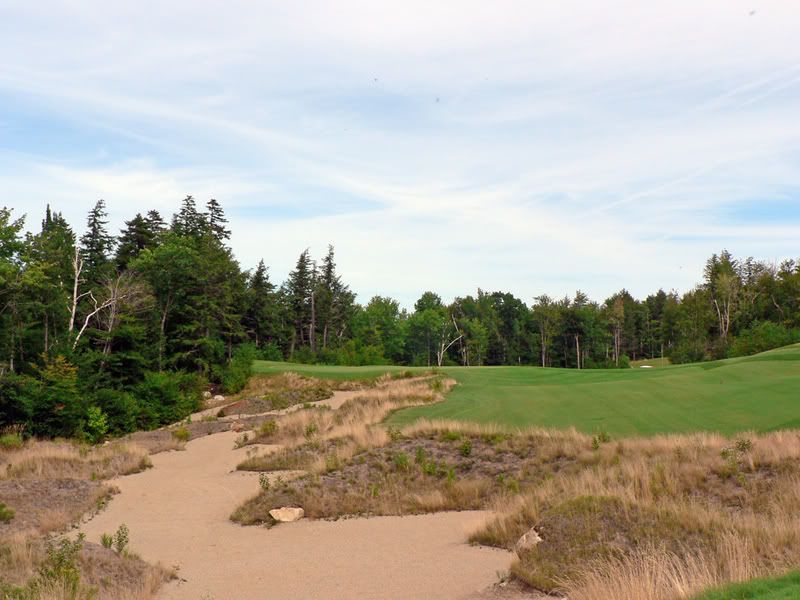
My favorite par 3 on the course, the 6th measures 180 yards and plays uphill. Imagine that . . . a par 3 that actually plays uphill. The waste area runs from tee to green, but there is plenty of room on the right to play safe. The green slopes severely from left to right, with some cool internal contouring.
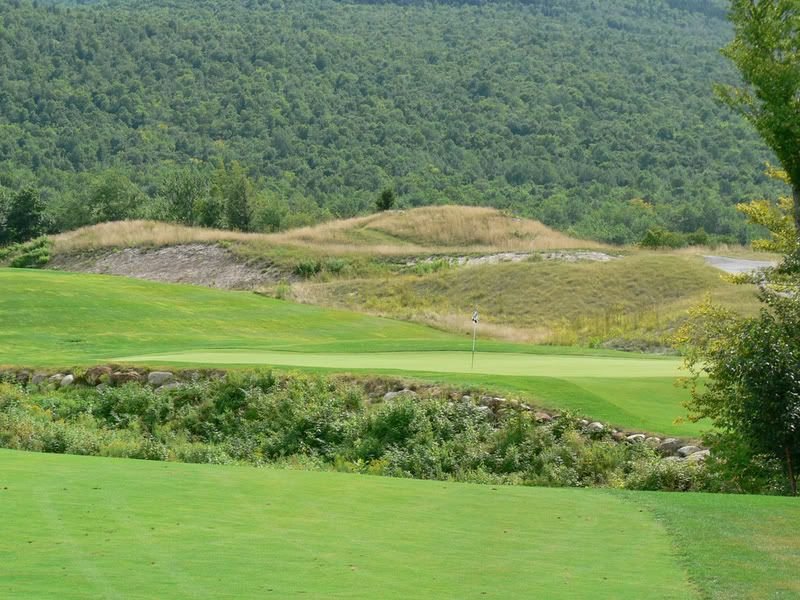
The 8th hole is a tough 410-yard dogleg left with a blind landing area off the tee. There was lots of room on the right to bail out, but you definitely want to play your second from the middle or left. The approach is a forced carry—a really difficult obstacle for the average golfer to negotiate.

The forced carries continue on 9, a 340-yard par 4 that plays downhill off the tee and then back uphill to the green. A hybrid down the left (over the bunkers) left a 9-iron to the green. As with the previous hole, the 9th has a forced carry that would be impossible to get over if you can't get the ball up in the air. Needless to say, the pace of play came to a sreeching halt on this part of the course.
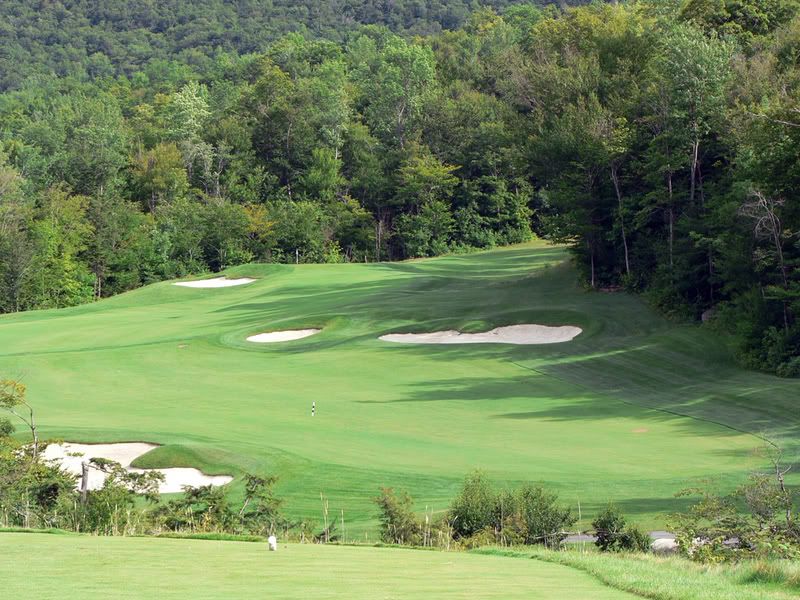
The back 9 begins with the most difficult forced carry on the course. The tee shot is over a gorge, and the distance to the very front edge of the fairway must be at least 150 yards. I would predict that a 15 to 20 handicap would successfully put the ball in play off this tee about 30% of the time. A good tee shot leaves about 150 yards uphill to a blind green. A hazard hugs the left side of the hole.

The 12th is the best of the downhill holes. Visually, it reminds me of the 5th at Blackstone National and the 11th at Yale. The difference being that the 12th at Sunday River is significantly longer at 412 yards and again has a big forced carry. It would have been neat to see an up tee to allow a big hitter to reach the green the way you can at Blackstone. Sunday River is lacking in those kinds of risk-reward decisions.
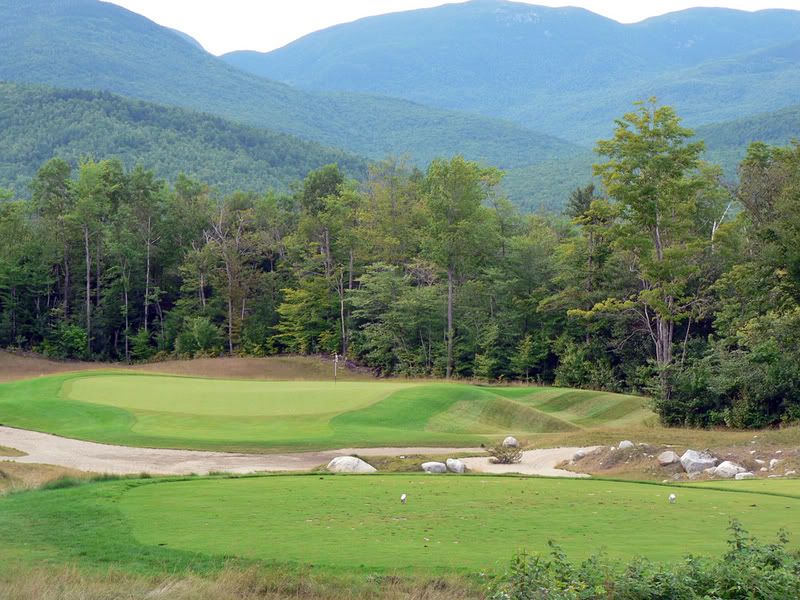
At 185 yards, the 14th plays slightly downhill with a green that is fronted by a waste area. The putting surface is creased horizontally with a ridge dividing the front and back.

The 15th is the last and best of the par 5s. At about 490 yards, it should be reachable in two, but there is a huge waste that cuts across the fairway about 250 from the tee. The first 200 yards play slightly uphill, so the waste area isn't visible from the tee—another time when a yardage book would have been very useful.
The positives:
1) Sunday River is a dramatic course that offers incredible views.
2) The course was in great shape. A few greens had been aerated, yet they still putted okay.
The negatives:
1) The course isn't walkable, which is a big detraction in my opinion.
2) The forced carries make pace of play a real problem. We teed off at 1:40 on a weedkay and didn't finish until 7:20. The group behind us quit after 14 because the course was so backed up.
3) The course was obviously routed to optimize the downhill holes. I got bored on the front 9 watching tee shots hang in the air forever, wondering where they would come down.
4) Along the same lines, with many, many doglegs that are all downhill, it is impossible for a person who has never played the course to know where to aim. It is very easy to hit through the dogleg and out of the ballpark, which, in this wooded setting, means a lost ball.
Other thoughts:
I greatly preferred the back 9 to the front. The back is probably more difficult, with some uphill holes thrown into the mix. Unfortunately, I took less pictures on the back because I started to enjoy myself more. The layout ends as it began, however, with a downhill, dogleg left par 4 that finishes at the clubhouse (a hole that was similar in bend and elevation change to the 2nd). Prior to that, the back was pretty interesting.
This is a resort course, so I would assume that on any given day most people are there for the first time. That being the case, the place will aways have pace of play issues. With the severe elevation changes on curving holes and the many, many forced carries, the average golfer had better get to the first tee packing a few extra sleeves of Top Flights.
I also thought the tee setup was too spread out. We had the choice of playing from the tips at 7,100, the blues at 6,550 or the whites at 5,800. That's not a lot of options. We had two people in our group who are decent players. 6,550 actually felt pretty short because of the downhill nature of the holes. I think we could have played from 7,100 without much of a problem. The other two play only a few times a year but they aren't terrible. The forced carries absolutely killed them, but even for them 5,800 would have been way too short. I would have liked to have had the tees at 6,200 and 6,700, but just a minor quibble.
In my opinion, the architecture of Sunday River can't compete with other upscale courses in the region such as Belgrade Lakes and Red Tail. The views give Sunday River a bump, but in 10 rounds against the other two, I might go 1 at Sunday River, 4 at Belgrade and 5 at Red Tail. Factoring in the length of a typical round at those courses, I would go with 1 at Sunday River, 2 at Red Tail, and 7 at Belgrade.